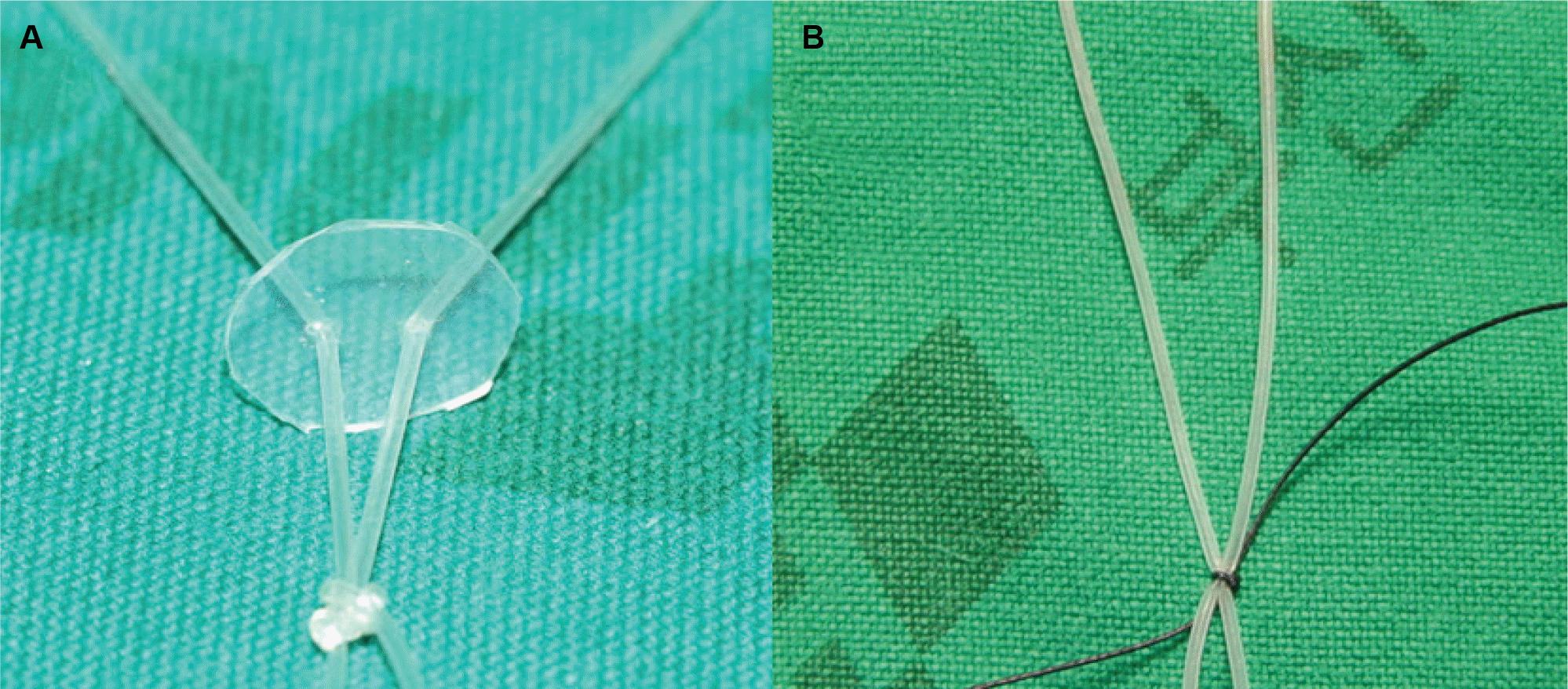Abstract
Methods
Eighty-eight eyes of 87 patients who underwent silicone tube intubation were divided into two groups based on the tie method: a silicone silastic sheet group (Group 1, n=59) and a nylon 6-0 suture knot group (Group 2, n=29). The two groups were compared according to their success rates, recurrence rates and complications.
Results
No significant difference was found in the success rate between the two groups (83.0% in Group 1 and 82.7% in Group 2). However, Group 2 showed a significantly higher rate of postoperative complications than Group 1. In Group 1, 5/59 (8.4%) eyes had ocular irritation, 2/59 (3.4%) eyes exhibited tube prolapse, conjunctivitis, corneal erosion, and dacryocystitis and 1/69 (1.6%) eyes had a punctal slit after intubation. In Group 2, 3/29 (10.3%) eyes had ocular irritation, 2/29 (6.9%) eyes exhibited tube prolapse, conjunctivitis, a punctal slit, and dacryocystitis, and 1/29 (3.4%) eyes showed corneal erosion, or a granuloma after intubation. A recurrence of symptomatic tearing was found in 6/59 (10%) eyes in Group 1 and 3/29 (10%) in Group 2.
Conclusions
In silicone tube intubation of incomplete NLD obstruction, the usage of silicone silastic sheets to tie both ends of the silicone tube produced a lower complication rate and a higher success rate than that of the suture knot group. Lower tension on the nasolacrimal passage in the silicone silastic sheet group allows for a significantly lower rate of punctal slit development. Therefore, the method of using silicone silasitic sheets can be considered useful in the treatment of NLD obstruction.
Go to : 
References
1. Dortzbach RK, France TD, Kushner BJ, Gonnering RS. Silicone intubation for obstruction of the nasolacrimal duct in children. Am J Ophthalmol. 1982; 94:585–90.

2. Al-Hussain H, Nasr AM. Silastic intubation in congenital nasolacrimal duct obstruction: A study of 129 eyes. Ophthal Plast Reconstr Surg. 1993; 9:32–7.
3. Pashby RC, Rathbun JE. Silicone tube intubation of the lacrimal drainage system. Arch Ophthalmol. 1979; 97:1318–22.

4. Leone CR Jr, Van Gemert JV. The success rate of silicone intubation in congenital lacrimal obstruction. Ophthalmic Surg. 1990; 21:90–2.

5. Lee SH, Kim SD, Kim JD. Silicone intubation for nasolacrimal duct obstruction in adult. J Korean Ophthalmol Soc. 1997; 38:185–9.
6. Soll DB. Silicone intubation-an alternative to dacryocystorhinostomy. Ophthalmology. 1978; 85:1259–66.
7. Anderson RL, Edwards JJ. Indications, complications and results with silicone stents. Ophthalmology. 1979; 86:1474–87.

8. Kim DM, Roh KK. Results with Silicone Stent in Lacrimal Drainage System. J Korean Ophthalmol Soc. 1987; 28:733–5.
9. Sohn HY, Hur J, Chung EH, Won IG. Clinical Observation on Silicone Intubation in Obstruction of Lacrimal Drainage System. J Korean Ophthalmol Soc. 1990; 31:135–40.
10. Crawford JS. Intubation of obstruction in the lacrimal system. Can J Ophthalmol. 1977; 12:289–92.
12. Ham DI, Yu YS. Silicone Intubation in Children with Nasolacrimal Duct Obstruction. J Korean Ophthalmol Soc. 1991; 32:409–14.
13. Cho KW, Lee SY, Kim SJ. Treatment of Congenital Nasolacrimal Duct Obstruction Using Silicone Intubation Set. J Korean Ophthalmol Soc. 1995; 36:553–8.
14. Henderson JW. Management of obstructions of lacrimal canaliculi with polyethylene tubes. Arch Ophthalmol. 1950; 44:198–203.
15. Hong SW, Chang HK. The Complications of Silicone Tube Intubation after Lacrimal Surgery. J Korean Ophthalmol Soc. 1998; 39:2496–76.
Go to : 
 | Figure 1.A tie made at the silicone silastic sheet by using silicone tube (A), and a tie made by Nylon 6-0 (B). |
Table 1.
Clinical Characteristics
| Groups | Group 1 | Group 2 | p-value |
|---|---|---|---|
| Age | 46.3 (15-75) years | 46.0 (21-61) years | >0.05† |
| Male : Female | 19 : 40 eyes | 8 : 21 eyes | >0.05* |
| Symptom duration | 12 (1.0-120) months | 11 (1.0-36) months | >0.05† |
| Tube removal | 4.6 (1.0-12.0) months | 5.1 (2.5-8.0) months | >0.05† |
| Success rate | 49/59 (83.1%) | 24/29 (82.7%) | >0.05* |
Table 2.
The Rate and the type of postoperative complications after Silicone tube intubation using silastic sheet or suture knot group in NLD obstructed patients
| Group 1 No. of eyes (%) | Group 2 No. of eyes (%) | ) P value* | |
|---|---|---|---|
| Ocular Irritation | 5 (8.4%) | 3 (10.3%) | > 0.05 |
| Punctal slit | 1 (1.6%) | 2 (6.9%) | 0.03 |
| Tube prolapse | 2 (3.4%) | 2 (6.9%) | > 0.05 |
| Granuloma | 0 | 1 (3.4%) | > 0.05 |
| Conjunctivitis | 2 (3.4%) | 2 (6.9%) | > 0.05 |
| Corneal erosion | 2 (3.4%) | 1 (3.4%) | > 0.05 |
| Inflammation of lacrimal passage | 2 (3.4%) | 2 (6.9%) | > 0.05 |
| Total | 14/59 (23.7%) | 13/29 (37.9%) | 0.04 |




 PDF
PDF ePub
ePub Citation
Citation Print
Print


 XML Download
XML Download